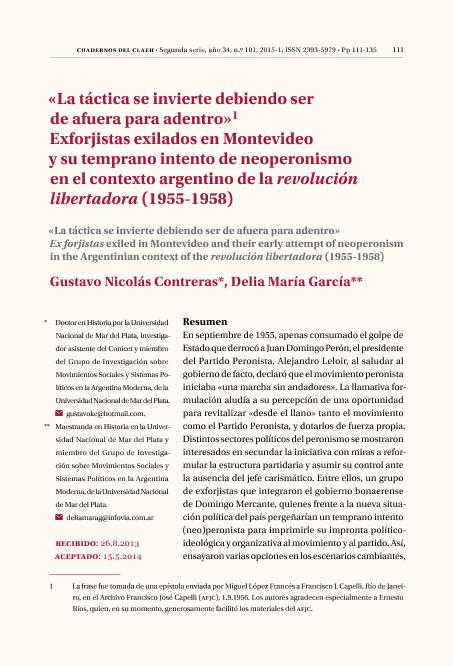Artículo
En septiembre de 1955, apenas consumado el golpe de Estado que derrocó a Juan Domingo Perón, el presidente del Partido Peronista, Alejandro Leloir, al saludar al gobierno de facto, declaró que el movimiento peronista iniciaba «una marcha sin andadores». La llamativa formulación aludía a su percepción de una oportunidad para revitalizar «desde el llano» tanto el movimiento como el Partido Peronista, y dotarlos de fuerza propia. Distintos sectores políticos del peronismo se mostraron interesados en secundar la iniciativa con miras a reformular la estructura partidaria y asumir su control ante la ausencia del jefe carismático. Entre ellos, un grupo de exforjistas que integraron el gobierno bonaerense de Domingo Mercante, quienes frente a la nueva situación política del país pergeñarían un temprano intento (neo)peronista para imprimirle su impronta políticoideológica y organizativa al movimiento y al partido. Así, ensayaron varias opciones en los escenarios cambiantes, que generaron la autodenominada revolución libertadora. Inicialmente, desde el semanario. El 45, apostaron a capitalizar la continuidad institucional del partido; más tarde, desde el exilio en Uruguay, impulsaron tanto la coordinación con militares peronistas golpistas como la realización de un Congreso Postal de Exilados; por último, se inclinaron por la formación de un frente electoral del que saldrían notablemente desfavorecidos. In September 1955, just after the coup that overthrew Juan Domingo Perón, the president of the Peronist Party, Alejandro Leloir, claimed when greeting the de facto government, that the Peronist movement was beginning a march “without walkers”. The striking statement envisaged an opportunity to revitalize both the movement and the Peronist Party from below and provide them with their own power. Different Peronist political sectors were interested in supporting the initiative in order to reformulate the party structure and assume control in the absence of the charismatic leader. Among them, there was a group of exforjistas who were part of the government of the Buenos Aires province while Domingo Mercante was in office. In view of the new political situation they made an early (neo) peronist attempt to imprint their political-ideological and organizational mark to the movement and the party. So, they tested several options in the changing scenarios that generated the self called Revolución Libertadora. Initially, they tried to capitalize party institutional continuity from the weekly magazine “El 45”, and later, from exile in Uruguay, they encouraged both the coordination with Peronist military who supported the coup and the creation of an Exiles Postal Congress. Finally, they attempted to constitute an electoral front, which, in turn, would leave them significantly disadvantaged.
La táctica se invierte debiendo ser de afuera para adentro: Exforjistas exiliados en Montevideo y su temprano intento de neoperonismo en el contexto argentino de la revolución libertadora (1955-1958)
Título:
«La táctica se invierte debiendo ser de afuera para adentro» Ex forjistas exiled in Montevideo and their early attempt of neoperonism in the Argentinian context of the revolución libertadora (1955-1958)
Fecha de publicación:
03/2015
Editorial:
Universidad CLAEH
Revista:
Cuadernos del CLAEH
ISSN:
0797-6062
Idioma:
Español
Tipo de recurso:
Artículo publicado
Clasificación temática:
Resumen
Palabras clave:
Ex Forjistas
,
Exilio
,
Posperonismo
,
Neoperonismo
Archivos asociados
Licencia
Identificadores
Colecciones
Articulos(CCT - MAR DEL PLATA)
Articulos de CTRO.CIENTIFICO TECNOL.CONICET - MAR DEL PLATA
Articulos de CTRO.CIENTIFICO TECNOL.CONICET - MAR DEL PLATA
Citación
Contreras, Gustavo Nicolas; Garcia, Delia María; La táctica se invierte debiendo ser de afuera para adentro: Exforjistas exiliados en Montevideo y su temprano intento de neoperonismo en el contexto argentino de la revolución libertadora (1955-1958); Universidad CLAEH; Cuadernos del CLAEH; 34; 101; 3-2015; 111-135
Compartir




